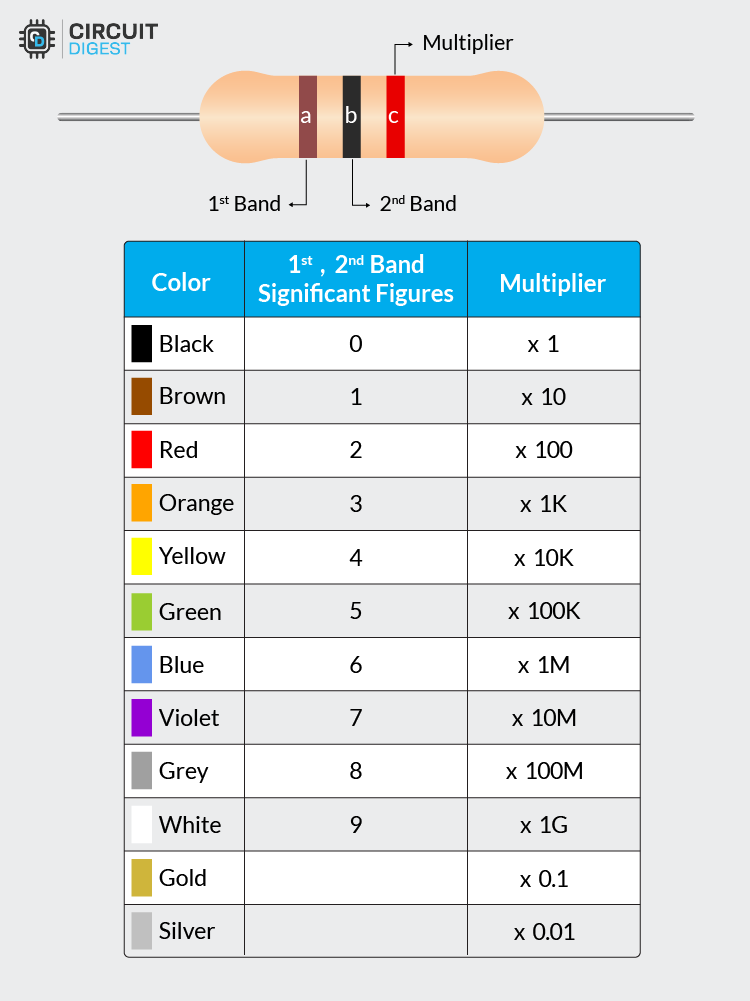Our 3-band resistor color code calculator provides quick and easy resistance calculations for the most basic resistor type. 3-band resistors are the simplest and most cost-effective option, featuring two significant digits and a multiplier with standard ±20% tolerance. Perfect for general applications, hobbyist projects, and educational purposes where high precision is not required.
How to Calculate 3-Band Resistor Values?
Calculating 3-band resistor values is the simplest resistor color code system to learn. With only three bands to decode - two significant digits and one multiplier - it's perfect for beginners and quick calculations. The absence of a tolerance band means these resistors have a standard ±20% tolerance, making them ideal for non-critical applications. Follow the color code chart below to understand the calculation process.
Understanding 3-Band Resistors
3-band resistors are the most basic and economical resistor type, making them popular in educational settings and budget-conscious projects. While they lack the precision of 4-band resistors or 5-band resistors, their simplicity and low cost make them perfect for many applications.
When to use 3-band resistors: Educational circuits, basic electronics projects, LED current limiting (use our LED resistor calculator), pull-up/pull-down resistors, and any application where ±20% tolerance is acceptable. For precision applications, consider upgrading to higher band count resistors.

Where,
'a' represents the 1st significant digit (first band color)
'b' represents the 2nd significant digit (second band color)
'c' represents the multiplier value (third band color)
| 3-Band | Name | Description |
| 1st Band | a | 1st significant digit |
| 2nd Band | b | 2nd significant digit |
| 3rd Band | c | Multiplier |
Step-by-Step 3-Band Resistor Calculation Example
Let's calculate a 3-band resistor with the colors: Brown, Black, Red
Step 1: First band (Brown) = 1
Step 2: Second band (Black) = 0
Step 3: Third band (Red) = ×100 (multiplier)
Calculation: (1×10 + 0) × 100 = 10 × 100 = 1000 Ohms or 1kΩ
Tolerance: All 3-band resistors have ±20% tolerance, meaning this 1000Ω resistor can actually measure between 800Ω and 1200Ω. This wide tolerance is why 3-band resistors are used in non-critical applications.
Common Applications for 3-Band Resistors
3-band resistors are perfect for applications where cost is more important than precision. Their ±20% tolerance makes them unsuitable for critical circuits, but ideal for many basic electronic projects and educational purposes.
Popular Uses for 3-Band Resistors:
Educational Projects: Learning electronics, breadboard experiments, and classroom demonstrations.
Basic LED Circuits: Simple current limiting for LEDs - calculate exact values with our LED resistor calculator.
Hobby Electronics: Arduino projects, basic circuits, and prototyping where precision isn't critical.
Pull-up/Pull-down Resistors: Digital input circuits where exact values aren't crucial.
Budget Projects: Cost-sensitive applications where component expense matters more than precision.
When to Upgrade from 3-Band Resistors:
Consider using our 4-band resistor calculator for ±5% tolerance applications, or our 5-band resistor calculator for precision circuits requiring ±1-2% tolerance. For power calculations, use our resistor wattage calculator regardless of band count.
3-Band Resistor Calculator FAQ
Why don't 3-band resistors have a tolerance band?
3-band resistors have a standard ±20% tolerance that doesn't require a separate color band. This simplifies manufacturing and reduces cost, making them the most economical resistor option. The tolerance is implied rather than explicitly marked.
Can I use a 3-band resistor instead of a 4-band or 5-band resistor?
Only if your circuit can tolerate ±20% resistance variation. For most precision applications, you'll need the tighter tolerances of 4-band resistors (±5%) or 5-band resistors (±1-2%).
Are 3-band resistors still commonly used?
Yes, especially in educational settings, hobby projects, and cost-sensitive applications. They're perfect for learning electronics basics and situations where exact precision isn't critical.
How do I know if my resistor is 3-band or 4-band?
Count the colored bands. 3-band resistors have exactly three colored bands, while 4-band resistors have four bands with the fourth being the tolerance band (often gold or silver).
What are the most common 3-band resistor values?
Common values include 100Ω, 470Ω, 1kΩ, 2.2kΩ, 4.7kΩ, and 10kΩ. These are standard E12 series values commonly used in basic circuits. Use our series resistor calculator when combining multiple values.
Update: This calculator was last updated in May 2025 to support the latest mobile devices and iPhone screens. If you are facing any problems in using our electronics calculators or have any suggestions, kindly contact us.

